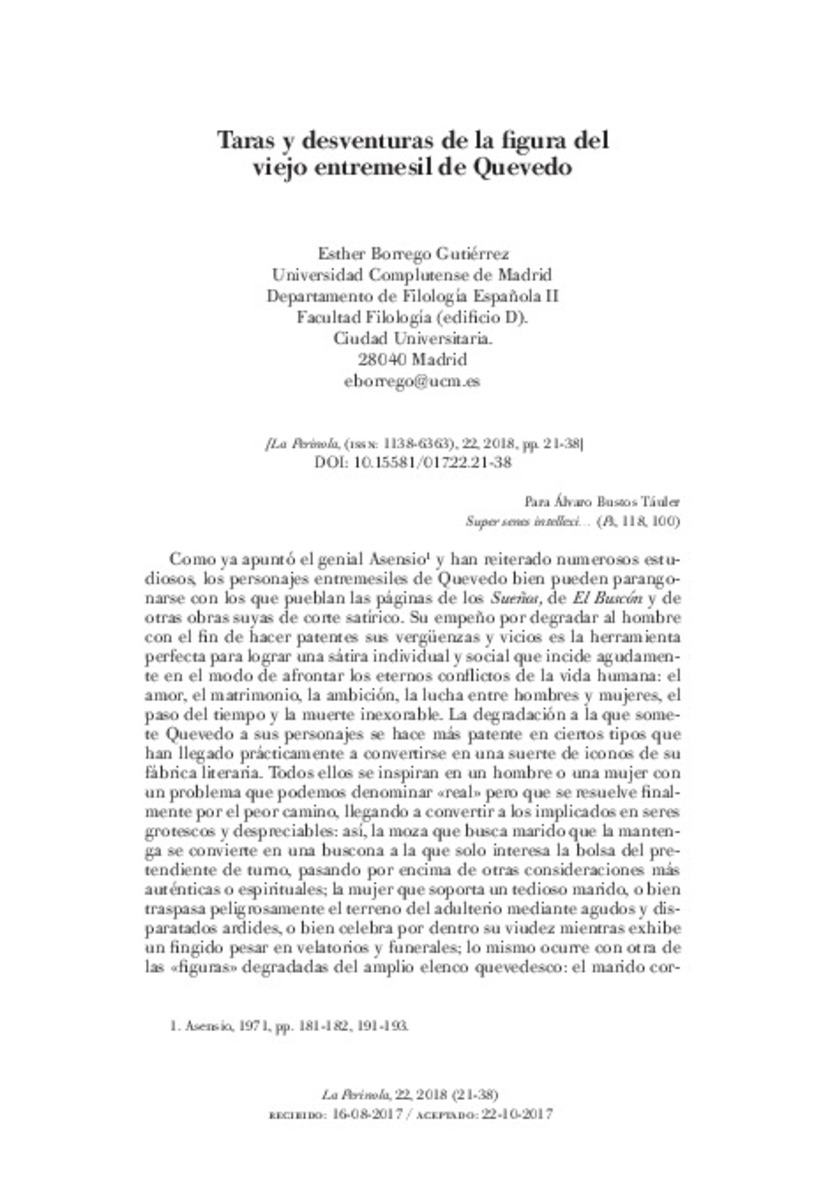Full metadata record
| DC Field | Value | Language |
|---|---|---|
| dc.creator | Borrego-Gutiérrez, E. (Esther) | - |
| dc.date.accessioned | 2018-07-02 | - |
| dc.date.accessioned | 2021-04-30T09:27:09Z | - |
| dc.date.available | 2021-04-30T09:27:09Z | - |
| dc.date.issued | 2018 | - |
| dc.identifier.citation | Borrego-Gutiérrez, E. (Esther). "Taras y desventuras de la figura del viejo entremesil de Quevedo". La Perinola. 22, 2018, 21 - 38 | es |
| dc.identifier.issn | 1138-6363 | - |
| dc.identifier.uri | https://hdl.handle.net/10171/60284 | - |
| dc.description.abstract | This paper will analyze the figure of the old man —a character amply rooted in literature and folklore— in Francisco de Quevedo’s interludes. Contrary to the perception of old age as a time of experience and wisdom, proper to other Quevedo’s works, in these texts the passing of time is primarily a reason for mockery. The presence of the old man amounts to that of a caricatured nincompoop. Compared to his female counterpart, however, the satire of the old man is toned down. We can even gather an authorial intention to show sympathy towards this impaired character, whose misfortunes are often, in fact, caused by a woman. The old man can be traced back to similar counterparts from interludes by Lope de Rueda and Cervantes. Although Quevedo does not add new or particular attributes to the character, he does present a peculiar and parodic roster of old codgers afflicted by myriad faults and frailties, and taunted not only by their own kin but also by society at large. | en_US |
| dc.description.abstract | Tomando como referencia el corpus de los entremeses de Francisco de Quevedo, se pretende mostrar el perfil de la figura del viejo, de amplias raíces folklóricas y literarias. Frente a la visión de la vejez como etapa vital de reflexión, experiencia y sabiduría, propia de otras obras quevedianas, en estos textos el paso del tiempo es en esencia un motivo de solfa, y la presencia del anciano equivale a la de un pelele caricaturizado. Sin embargo, en contraste con su homóloga femenina, la sátira es menor cuantitativa y cualitativamente e incluso puede adivinarse la intención de provocar cierta compasión hacia su desventura física y moral, muchas veces provocada precisamente por una mujer. Las fuentes teatrales más próximas de la figura son los personajes de ciertos entremeses de Lope de Rueda y de Cervantes; aunque Quevedo no añade al personaje ningún rasgo nuevo ni particular, sí consigue un peculiar y paródico desfile de vejetes que arrastran sus defectos físicos y morales en medio de la chanza de sus familiares y deudos y por ende de toda la sociedad. | es_ES |
| dc.language.iso | spa | - |
| dc.publisher | Servicio de Publicaciones de la Universidad de Navarra | es_ES |
| dc.rights | info:eu-repo/semantics/openAccess | es_ES |
| dc.subject | Teatro cómico breve español del siglo XVII | - |
| dc.subject | Figuras de entremés | - |
| dc.subject | Personaje del viejo en la literatura jocosa del siglo XVII | - |
| dc.subject | Teatro de Francisco de Quevedo | - |
| dc.title | Taras y desventuras de la figura del viejo entremesil de Quevedo | es_ES |
| dc.title.alternative | Flaws and misfortunes of the old man character in Quevedo’s interludes | en_US |
| dc.type | info:eu-repo/semantics/article | es_ES |
| dc.identifier.doi | 10.15581/017.22.21-38 | - |
| dadun.citation.endingPage | 38 | - |
| dadun.citation.publicationName | La Perinola | - |
| dadun.citation.startingPage | 21 | - |
| dadun.citation.volume | 22 | - |
Files in This Item:
Statistics and impact
Items in Dadun are protected by copyright, with all rights reserved, unless otherwise indicated.






